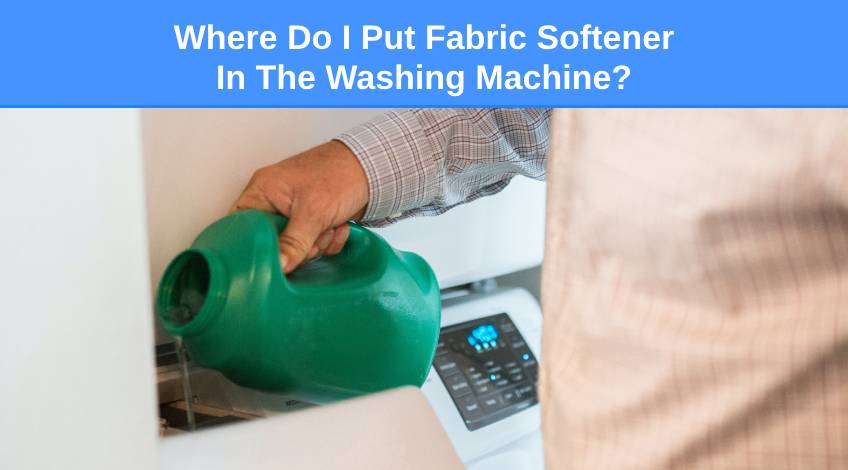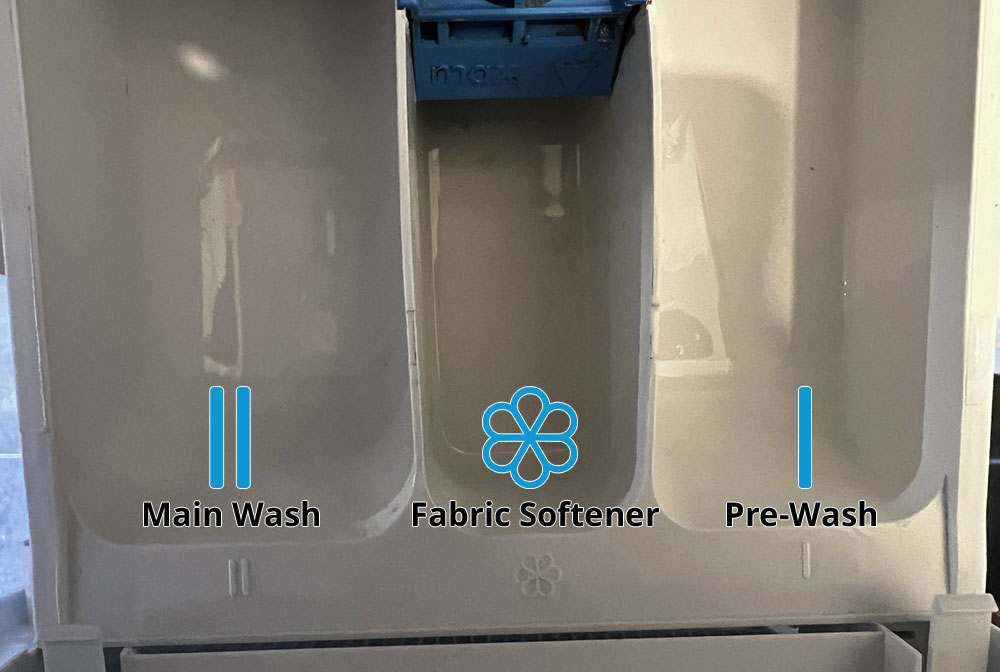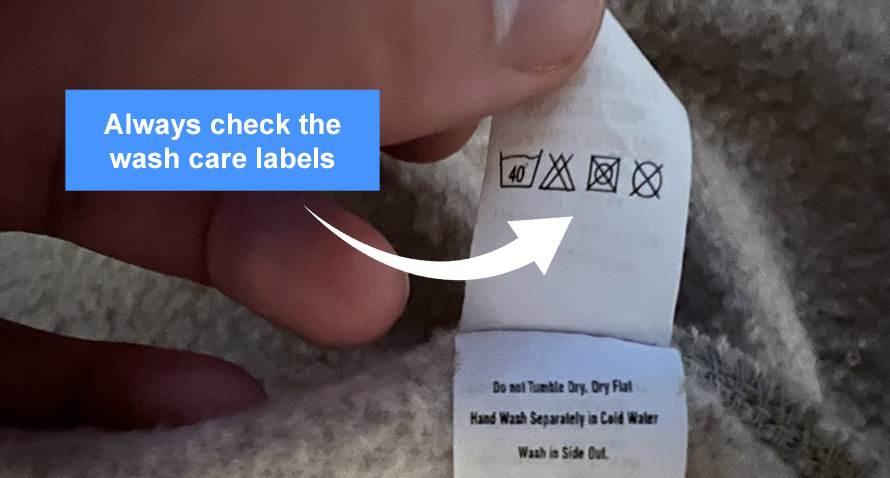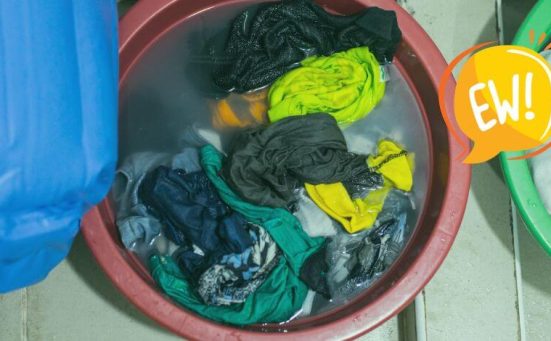
Where Do I Put Fabric Softener In The Washing Machine?
If you’ve ever wondered where to add fabric softener in your washing machine, you’re not alone. Many people are curious about this, especially if they’re new to doing laundry or have a new washer.
Don’t worry; adding fabric softener to your washing machine is easy – you simply place it in the dispenser drawer of your washer.
In this article, we’ll learn how and where to put fabric softener in your washing machine, why you should use it, and some important tips to make sure your laundry comes out soft, fresh, and clean.
Add Fabric Softener To Your Washer’s Dispenser Drawer

Most modern washing machines come with a dispenser drawer, making it easy to use fabric softener. This drawer is typically divided into 3 parts: 1 for detergent, 1 for fabric softener, and 1 for pre-wash products.
To add fabric softener to your washing machine, you need to:
- Identify The Fabric Softener Compartment
The symbol for the fabric softener compartment may vary depending on your washer’s brand and model. Look for a label with the number 3, a star, or a flower symbol. If you’re unsure, check your appliance’s manual for guidance. - Check The Maximum Fill Line
Inside the dispenser drawer, you’ll usually find a maximum fill line indicating the right amount of fabric softener needed. This helps to make sure you won’t overfill the dispenser. - Pour In The Fabric Softener
Add the specified amount of fabric softener into the designated fabric softener compartment. The washing machine will take care of the rest, dispensing the fabric softener at the right time during the wash cycle.
Don’t Put Fabric Softener Straight In Your Washer Drum
It’s important to note that you should not pour fabric softener directly into the drum of a front-loading washing machine. Why? Fabric softener needs to be properly diluted with water to work effectively. Adding it directly to the drum could result in uneven distribution, leading to staining and spotting on your clothes.
However, if you have a top-loading washer that lacks a dispenser drawer, there is a proper way to add fabric softener, which we’ll explain later in this article.
Do I Need To Use Fabric Softener?

Clothes move a lot inside your washing machine during a wash cycle, and all that moving around can make their threads rub against each other. Over time, this friction can lead to a rough texture in your clothes.
But that’s not all. Hard water, which is water with a high mineral content, can also be another reason. When hard water meets your clothes, it can leave them feeling scratchy and rough after several washes.
Now, here’s the good news: if your main goal is clean and fresh laundry, your laundry detergent has got you covered. Laundry detergent focuses on removing dirt and odours, making sure your clothes are clean. Fabric softener, on the other hand, doesn’t have much to do with cleanliness. Instead, it’s all about keeping your laundry soft and smelling fresh for a more extended period. So, if you’re all about cleanliness, detergent alone will do the trick.
Pro Tip: Using an all-in-one capsule that combines laundry detergent and fabric softener may not be the best idea. Adding both at the same time can confuse your detergent, which might think the fabric softener needs cleaning. Your washer’s dispenser drawer makes sure that fabric softener is distributed during the rinse cycle, away from the detergent’s cleaning action. So, stick to separate products for the best results.
Pros and Cons of Using Fabric Softener
Fabric softeners, as their name implies, have several advantages when used in your laundry routine. They can improve your clothing in different ways:
- Your Clothes Are Softer
Fabric softeners condition each individual fibre, protecting and preventing the threads of your clothes from becoming tangled. This helps reduce the roughness and scratchiness of your clothes, making sure your clothes stay comfortable and in great shape for a long period of time. - Less Ironing Of Clothes
When you use fabric softener, you’re not just in for softer clothes; you’re also in for a smoother experience. Your laundry emerges from the washing machine or dryer with fewer wrinkles, which means less time spent ironing. Plus, if you prefer to wear your clothes right out of the dryer, you’re more likely to do so confidently. - No More Static Cling
Fabric softeners work wonders in reducing static cling that causes your clothes to stick together or even cling to your skin. This is especially helpful during colder months when static electricity tends to be more problematic. By using fabric softener, you’re creating a shield that keeps your clothes from sticking with each other, making sure they’re easier to separate and more comfortable to wear. - Longer-lasting Freshness
Fabric softeners help lock in that clean, fresh fragrance, so your laundry smells as lovely coming out of your wardrobe as it did coming out of the dryer. This means you can enjoy that “just laundered” scent even days after your clothes have been put away.
However, it’s important to be aware of some disadvantages when considering fabric softener:
- Fabric Sensitivity
Certain fabrics may not respond well to fabric softeners. For example, fabric softeners could reduce the absorbency of materials like towels as they leave residue on the fabric’s surface. This makes the fabric less effective at soaking up moisture, affecting its ability to absorb water and do its job. - Sticky Residue
When fabric softener isn’t properly diluted, it can result in sticky residue on your clothing. This happens because the undiluted fabric softener may not have been distributed evenly during the rinse cycle. Over time, this residue buildup can happen not only on your clothes but also inside your washing machine. The residue in your washer can potentially cause issues, affecting its performance and cleanliness. - Flammable Ingredients
Fabric softeners contain ingredients that are flammable, they can increase the flammability of the materials they come into contact with. For safety, it’s best to avoid using fabric softeners on bedding or flame-resistant clothing. The fabric softener may weaken the fire-resistant properties of these items, potentially leading to safety hazards.
Use Fabric Softener For Sensitive Skin
If anyone in your family has sensitive skin, you might want to consider using a fabric softener. It can be really helpful in preventing skin irritations that can happen when you wear clothes that feel scratchy and rough.
But here’s the important part: not all fabric softeners are the same. Some fabric softeners can contain chemicals or fragrances that may trigger skin irritations or allergic reactions. For those with sensitive skin, it’s best to pick a fabric softener that’s labelled “hypoallergenic.”
This special type of fabric softener is specifically made for sensitive skin. It’s designed to be gentle on your skin while still doing an excellent job at softening your clothes. It’s a simple way to keep your clothes comfortable and your skin happy at the same time.
Always Check Your Clothes’ Care Label

Before adding fabric softener to your laundry, it’s a good practice to take a moment and consult the care labels on your clothes. The labels provide an important guide on how to best care for your clothes.
While these labels might not feature a specific symbol for fabric softener, they usually contain important information about the materials used in the clothing and offer care instructions. For instance, they may show the recommended washing temperature, drying method, and ironing instructions.
Sometimes, you may see statements like “Do Not Use Fabric Softeners” on labels for items that are particularly sensitive to fabric softener. This is important because it helps you avoid any potential issues, such as residue buildup or damage to certain fabrics, making sure your clothes stay in top condition.
How to Use Fabric Softener When Hand-Washing Clothes

When it comes to hand-washing your clothes and using fabric softener, there are a few things to keep in mind. First, remember to use fabric softener effectively, you’ll need to dilute it properly.
The key is to follow the instructions and recommended dilution ratio provided on your fabric softener’s bottle. These guidelines are there to make sure you achieve the best results. Overdiluting or under diluting the fabric softener can affect its performance.
Once you’ve prepared the fabric softener mixture according to the instructions, it’s time to get your clothes ready for a soak. Before putting them in, give the mixture a good swirl or gentle stir. This step is important to make sure that the fabric softener is evenly distributed in the water.
Where Do I Put Fabric Softener In A Top-Loading Washer?
In the case of top-loading washers, which are more commonly found in the US and Canada, the process is slightly different. The dispenser drawer for fabric softener depends on the brand and model of your washing machine. Some may have this feature, while others may not.
If your top-loading washer doesn’t have a built-in dispenser drawer for fabric softener, you’ll have to add it manually to the drum. Here’s how to do it:
Add The Fabric Softener During Rinse Cycle
During the rinse cycle, your washing machine is busy removing the detergent and dirt from your clothes. At this point, the fabric softener can mix evenly with the water, making sure it’s properly diluted. This thorough mixing helps prevent any concentrated fabric softener from coming into direct contact with your clothes.
If fabric softener isn’t diluted correctly, it could lead to staining and spotting on your garments. So, adding it during the rinse cycle guarantees that it’s evenly distributed and won’t cause any unexpected surprises when you take out your freshly washed clothes.
Important Note: Remember that you can only pour fabric softener directly into the washing machine drum if you have a top-loading washer without a dispenser drawer. It’s always best to refer to your washer’s manual for any specific instructions on how and when to add fabric softener. Understanding the correct way to use fabric softener guarantees the best results for your laundry.
Frequently Asked Questions
In a washing machine drawer, you typically find three compartments: one for detergent, one for fabric softener, and one for pre-wash products.
If your washing machine lacks a dispenser, you can add fabric softener directly into the drum during the rinse cycle for top-loading machines.
Generally, you should add laundry detergent first, and then fabric softener to the appropriate compartment in your washing machine’s dispenser drawer.
The amount of fabric softener to use in a front-load washer varies depending on your machine’s capacity and the product’s instructions. Always check the fabric softener compartment’s maximum fill line for guidance or the user’s manual.
In a top-loading washer, fabric softener can be added manually during the rinse cycle. It mixes with water to guarantee proper dilution, preventing staining and spotting on your clothes.
It’s not necessary to use fabric softener on every load. Fabric softeners primarily focus on softening and scenting your laundry, so you can choose to use it as needed or based on your preferences.
Also, follow us on Pinterest ...



